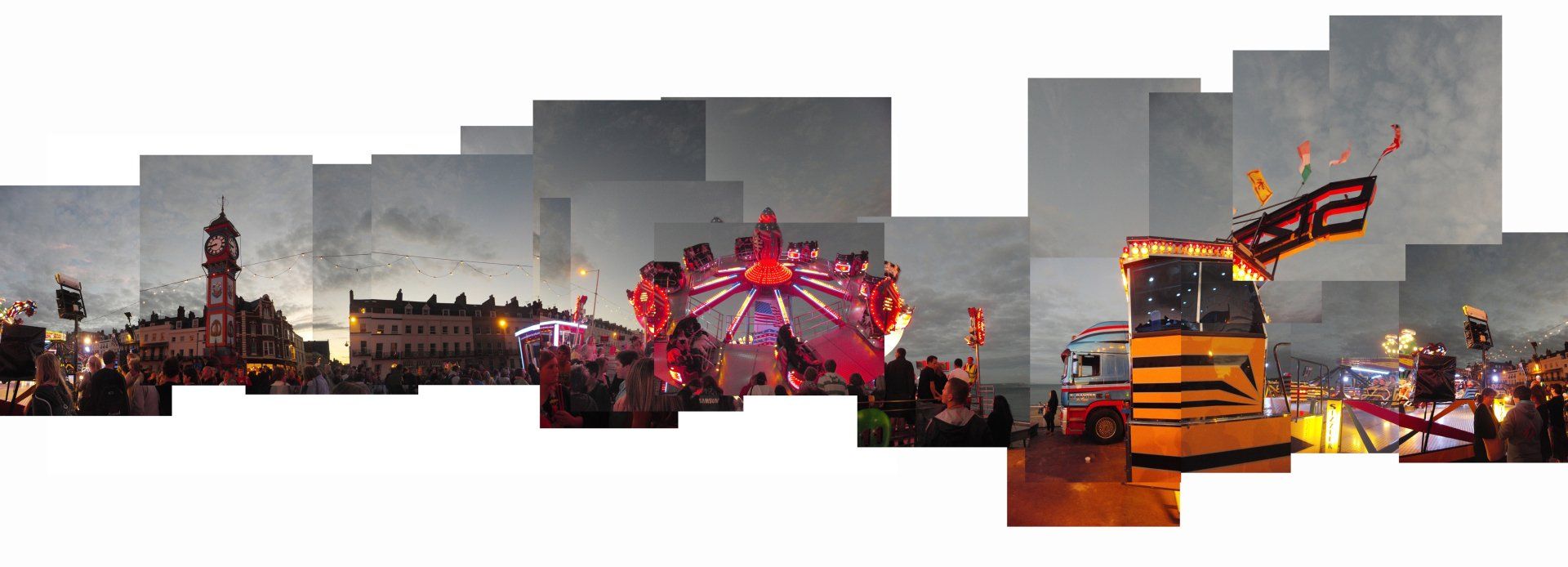
fragments of an autobiography / two
2001 - 2015 digital connections

The new century provided photography with its most significant changes since George Eastman introduced the Box Brownie. Who could have thought in the first years of the century the extent to which the collection and delivery platforms of imaging could progress in this decade? It gave what we knew as photography a new and vibrant agenda. In particular we missed the chemical darkrooms for processing but embraced the digital darkroom on our desktop.But I'm yet to be convinced that the new technology has given me a parallel path of craftsmanship.
My original Leica digital camera, the photo-constructions and the Bullring project came together almost as an element of chance, with an exhibition at Mary Walker's 'Focus on Imaging' at the NEC and sponsorship by Casio a spinoff from this. These are my Casio years. The opening of Bullring, the book and the exhibition, with Gil Gillis provided at St Martin's Church in the Bull Ring, and its footfall of some 130,000 was an unanticipated bonus. Brumpics, with Gil Gillis provided the community Arts Council sponsored 'Inner Circle Eight' and 'Church' projects. 'Seaside' became the next project that culminated in Olympic Coast, both as website and book, the interpretation of the coastline that provided the sailing venue of the London 2012 Olympics.
My pro bono involvement with the Royal Photographic Society has embrace in excess of 33-years. My more significant contributions include being simultaneously Chair of the Distinctions Advisory Board (DAB) and the Fellowship Board (2008-2012), chair of their Education Board (2012-2014); and establishing the qualification for the 'Creative Industries', and chairing the CIQ Qualification Board (since 2014).
Bull Ring, Birmingham
19 Nov 2002, Connecticut: While in London recently, I came across some unusual photographic work. As a long time active member of the ASMP, I'm always on the lookout for new ideas and photographic points of departure . That's why I was so taken with Michael Hallett's latest works.
Hallett has taken an old idea and put a new twist to it. He's taken montage photography into a new and interesting direction. His images differ from those of Barbara Morgan and Man Ray.He's actually devised a way to turn the more than half a century old concept into something new, and it communicates -- something that is hard to achieve no matter how or what you photograph.
The latest application of his unique technique is being used to capture the evolution of one of the largest commercial construction projects in the United Kingdom. He shows the steps it takes to build the mammoth Bull Ring project in Birmingham.
His work has captured an interesting piece of history in a thought-provoking manner that will one day be used to teach architects and historians how things were done in the early days of the 21st century. He demonstrates how dreams are transformed into reality. It is engaging, even to the most passive viewer who has no real interest in photography or construction.
His photography is truly creative and technically challenging. There is art in his work... even a sense of poetry. Most interesting is the fact that he has made a commercial success out of his work as a communicator and artist. Hallett has turned his unique vision into a vehicle that demonstrates the complexity of transitional space into a viable commercial photographic application.
Photographers looking for new products to offer their clients, students of photography and people with a need to express themselves visually, should take notice of Hallett's technique for demonstrating history in the making.
Yes, there is something new in photography ... and its being done in England. (Rory J. Pszenitzki. 2002)
2012 - continuing: constructed reality / inconsequential images
Life moves on and some of our grandchildren were living just down the road from us. We spend time with them and some time travelling.; opportunities reflected the purpose for which the camera was frequently used. What had gone before became the bedrock for the future. We found Lanzarote as an escape for the winter months that led directly to the Lanzarote Experience that then became iPhoto books providing picture telling and picture-selling opportunities. There would always be the challenge between photos that an audience would be comfortable with and those that see the world with harsher truth. Now this viewpoint is taking hold with more vibrant images considering a more intimate personal view of our world. This view tends to observe the more brutal rather than the beautiful aspects of our society. This is my constructed reality. It is showing 'some things that happened'.
Pushing the parameters of the way you work is natural curiosity and alternative directions. In its formal sense, I'm not a landscape photographer, though the landscape albeit rural or urbanisation frequently the subject of my gaze. The photo-constructions are increasingly seen as my my signature and they need to be woven into the story but in new ways. In that form, they are my intellectual property that would be lost at my peril. This is a continuing intellectual argument I have with myself.
Phrases that matter ...
Some would call them 'sound bites', but that would do them a disservice. Specifically they add in some way to the creative process.
Chaos Theory: non-linear and non-predictable. A small change makes a large difference.
Reality and Perception: It ain't what you said, but more what I heard.
Identifying with the crowd.
The extraordinary can be the ordinary.
In the 21st century, the rigid divisions of photography have collapsed.
Visual anarchy (is) glorious creativity.
The butterfly effect. Where a small change makes significant movement.
My major ambition is to stay relevant, (and) to be in the conversation.
curatorial, community & editorial projects
BRUMPICS initially was a focus for imaginative and persuasive imagery provides opportunity for commerce, industry and the professions. BRUMPICS is a loose and changing cooperative of independent Birmingham photographers. BRUMPICS was both facilitator and collaborator, and harnesses the wealth of photographic talent within the region.
INNER CIRCLE 8 finds its inspiration in reflections about Birmingham's Inner Circle 8 (8A/8C) bus route. The new community musical Ridin' the No8 was first shown at The Birmingham Rep in June/July 2004. Birmingham based photographers -- Vanley Burke, Ravi Deepres, Michael Hallett, Kristin Lyseggen, Stan Morgan and Luke Unsworth -- worked on various themes creating images that reflect the city's character along this historic bus route. Funded by the Arts Council.
CHURCH was a collaboration by St.Martin's Church in the Bull Ring and Brumpics. Funded by the Arts Council. CHURCH displays the work of five professional photographers in capturing and celebrating the unique and diverse community that represents St.Martin's. and shown throughout August 2005. The photographers -- Harmeet Chagger, Anand Chhabra, Barb Downs, Luke Unsworth and Stuart Whipps. Exhibition curated by Michael Hallett.
the Worcester book (2002) and the Worcester book (2012) were community learning projects outcomes edited or co-edited by Michael Hallett.
The Commonwealth Society. For three years from 2010 to 2012 he was chair of the assessment panel for the Commonwealth Youth Photographic Awards scheme. He was also involved with the 2012 Time Capsule that invited the people of the Commonwealth to tell their stories that relate to the years that lead up to the Queen's Golden Jubilee. His observation on 14 November 2012 when the Queen received the capsule were: 'The capsule was a significant event in the development / progress of picture journalism / citizen journalism on a Commonwealth / World stage.
on a formal note ....
Michael Hallett holds a PhD by Published Work in which he considered 'the role of Stefan Lorant in the development and continuing evolution of picture based journalism' (2008). He was also awarded a research masters (MPhil) for his work into the 'significant years of the history of photography in the Manchester area between 1840 and 1880' (1976). In 1967 he became a Fellow of the Royal Photographic Society (FRPS) at the age of 27-years, a Fellow of the British Institute of Professional Photography (FBIPP) a year later. He is a Member of the Chartered Management Institute (MCMI) and is a former Fellow of the Chartered Designers (FCSD).
British Institute of Professional Photography: At the age of 26-years he became the youngest member of the National Council of the British Institute of Professional Photography, and was one-time member then deputy chair of the BIPP's Admissions & Qualifications Board for Education & the History of Photography.
Royal Photographic Society: He was continuously involved as a volunteer with the Royal Photographic Society for 34 years from 1990 through to 2023. From 1990 until 2008 he was member, deputy chair, then chair of the Research, Education & Application of Photography (REAP). From 2016 to 2021 he again chaired REAP, which under his direction evolved into Research distinction, embracing The Society's original mission statement by representing the Arts and Sciences of photography. For four years, from 2008 to 2011 he was Chair of both The RPS Distinctions Advisory Board (DAB) and the RPS Fellowship Board, enhancing quality issues and delivery of the distinction process. During these years he was a member of the Awards Committee, selector for the RPS 149th International Print Exhibition, and part of the editorial team for
Portfolio One,
Portfolio Two and
Portfolio Three. From 2011 to 2013 he was Chair of Education for the RPS Education Working Group, enhancing The Society's key commitment as an educational charity. In 2012 he received the Fenton Medal, for 'outstanding contribution to the work of The Society'. In 2013 he created and developed the Creative Industries Qualification (CIQ) allowing The Society to embrace elements of 21st century communications and media professions that that are part of the U.K.'s £100 billion powerhouse. This brings those who 'use photographs rather than make them' within the remit of The Society's qualifications. He was Chair of the CIQ Board. until the end of 2023.
Media: Consultant for Stefan Lorant: man in pictures, a 50-minute documentary on widescreen digital video by the Dutch independent company Odusseia Documentaries, initially for AVRO Television (The Netherlands). Premiere in Utrecht, September 1997 receiving a 'Golden Calf' nomination for best short documentary. Awarded the Banff Rockie Awards 'Special Jury Prize' at the Banff Television Festival in June 1998.
Consultant and contributor for the BBC Radio 4 Kaleidoscope feature Stefan Lorant: an extraordinary eye, first broadcast January 3rd 1998. Contributor to BBC Radio 4 'Archive Hour' Hitler's Prisoner, Churchill's Friend broadcast June 18th, 2005.

Michael Hallett





















